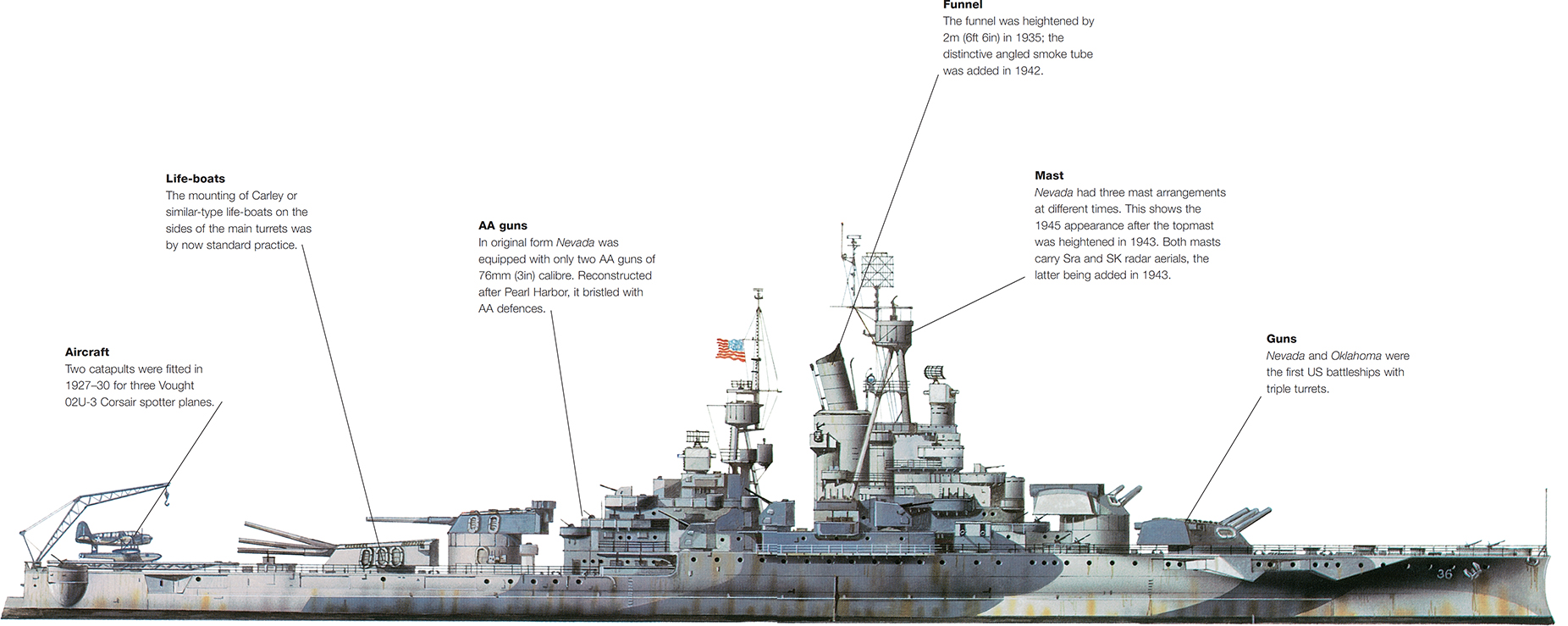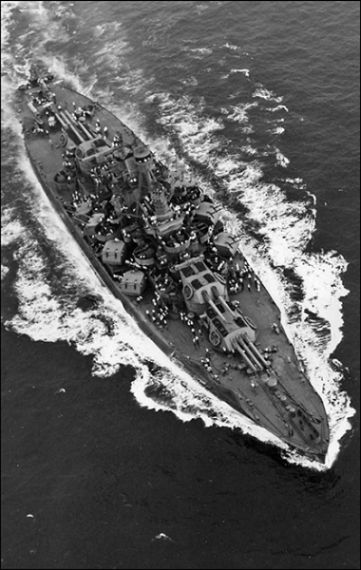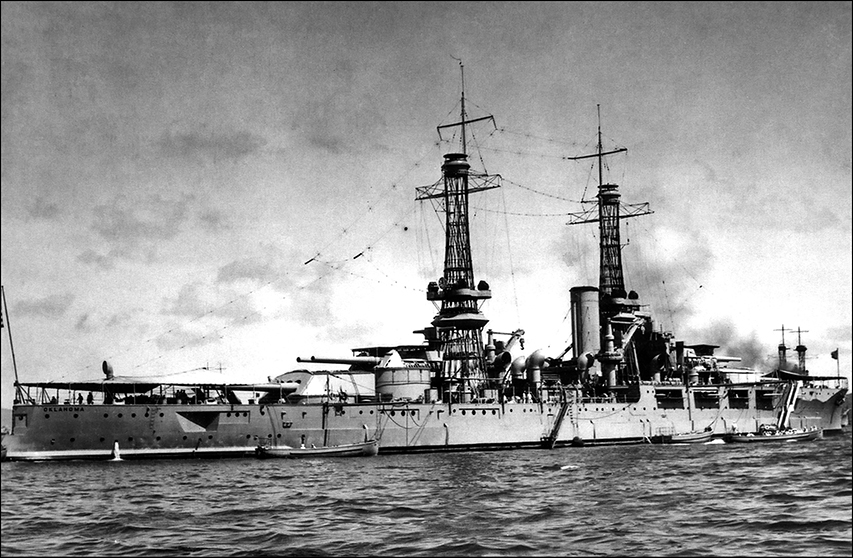 Nevada (1916)
Nevada (1916) Nevada (1916)
Nevada (1916)The United States’ first ‘super-dreadnoughts’, the two ships of the Nevada class incorporated a number of new features, including a revised armour arrangement, oil-firing and triple turrets.
Nevada, BB36, was laid down at Fore River Shipbuilding Co. at Quincy, Massachusetts, on 4 November 1912, launched on 11 July 1914 and commissioned on 11 March 1916. The US Navy by now was a formidable force and not short of innovative ideas. Having established the all centreline turret arrangement in 1906 (see South Carolina), it now established a new arrangement of protection.
Firing tests in 1911 against the old battleship San Marcos (ex-USS Texas) showed that light armour was of no value against heavy shells, and instead heavy armour, 343mm (13.5in) thick, was applied on 122m (400ft) of the 175.26m (575ft) waterline, with 203mm (8in) over the 18.9m (62ft) to the rudder-head. The barbettes also had 343mm (13.5in) protection as did the funnel uptakes, and the turrets had 457mm (18in) on the faces, 406mm (16in) on the sides and 254mm (10in) on the tops.

The profile shows Nevada as it looked in 1942, refitted after being damaged during the Japanese attack on Pearl Harbor, 26 years after its commissioning in 1916.
Other parts were not armour-protected, though internal bulkheads and an armoured deck were fitted. This, though not a new idea (see HMS Inflexible), was thoroughly worked out as the ‘all or nothing’ principle and became standard practice in battleship design after 1918. Weapons included 10 356mm (14in) guns, six of them in triple turrets. The guns were the same as those of USS Texas, though the triple sets were mounted in common cradles which meant that they could not be individually elevated. Nevada was powered by turbines while its sister ship Oklahoma had reciprocating engines; both were oil-fired, the first US battleships to be exclusively oil-burners.
Significant alterations were made during 1927–29. The secondary battery, originally in casemates below the forecastle deck, was raised to deck level, with the forward and aft guns removed, which made it more usable in rough conditions. The torpedo tubes were taken out and anti-torpedo bulges applied to the hull. Catapults were mounted on ‘X’ turret and on the stern ‘fantail’ deck, and tripods replaced the basket masts. These tripods were of massive construction, carrying three-decked platforms with control, observation and signalling positions.
In the post-Pearl Harbor reconstruction, the appearance of Nevada was again drastically altered with a unique rearwards-tilted cap mounted on the funnel, the rear tripod removed and an array of SK and SRA radar aerials mounted on the forward tripod. The control tower was heightened, with Mk37 gunnery control equipment to control eight new 127mm (5in) twin-gun mounts.
In total 48 40mm (1.5in) and 27 20mm (0.79in) AA gun positions were installed, massed on the superstructure, which was redesigned to give them the widest possible firing arcs, and also fitted in emplacements on the bow and stern. Life-rafts were fitted on each side of the four turrets. As with many other US battleships an aircraft crane was mounted on the fantail.
Specification
Dimensions |
Length 583ft 4in (177.8m), Beam 95ft 3in (29m), Draught 28ft 5in (8.7m), Displacement 24,947 tonnes (27,500 tons); 26,217 tonnes (28,900 tons) full load |
Propulsion |
12 Yarrow boilers, 2 Curtis turbines plus 2 geared cruising turbines developing 19,761kW (26,500hp), 2 screws |
Armament |
10 356mm (14in) guns, 21 127mm (5in) guns, 2 76mm (3in) AA guns, 2 533mm (21in) torpedo tubes |
Armour |
Belt 343–203mm (13.5–8in), Bulkheads 38mm (1.5in), Deck upper 76mm (3in), Deck lower 38mm (1.5in), Funnel uptakes 305mm (12in), Barbettes 343mm (13.5in), Turrets 457–127mm (18–5in) |
Range |
18,520km (10,000nm) at 10 knots |
Speed |
20.5 knots |
Complement |
864 |
Nevada joined the Atlantic Fleet in 1916. From August to December 1918 it was based at Bantry Bay, Ireland, and with the end of hostilities returned to join the Atlantic Fleet. From 17 September 1927 to 26 November 1929 it underwent modernisation at Norfolk Navy Yard, and in early 1930 transferred to the Pacific Fleet. At Pearl Harbor on 7 December 1941 it was hit by an aerial torpedo and five bombs, and beached in shallow water. Refloated on 12 February 1942, it was repaired at Puget Sound and, with superstructure completely rebuilt, returned in early 1943 to Pacific operations at the Aleutian Islands, then from June returned to the Atlantic.

Nevada sometime after its 1942 refit, with much-enhanced anti-aircraft defences in evidence. A plane is poised for take-off at the stern.
Convoy escort duties were followed by support for the Normandy landings in June 1944, when it bombarded the French port of Cherbourg and German tank formations inland. In August it was deployed to the Mediterranean to assist in landings on the southern French coast. On return to the USA later that year it had new gun barrels fitted and went again to the Pacific, in action at Iwo Jima and Okinawa between February and June 1945. Hit on 27 March 1945 by a kamikaze aircraft, it was only lightly damaged.

Nevada’s sister-ship Oklahoma was the last US warship to have triple expansion reciprocating machinery. Sunk at Pearl Harbor, it was formally decommissioned on 1 September 1944.
Nevada was decommissioned at Pearl Harbor on 30 October 1945. In 1946 it was used as a target in the Bikini Atoll atomic bomb tests but remained afloat. Despite further use as a target ship, including shelling from USS Iowa’s 406mm (16in) guns, it survived until sunk by an aerial torpedo on 31 July 1948.
Oil firing
The transition to oil firing had a major influence on design. On earlier battleships, lateral coal bunkers had been considered as part of the defensive system, able to absorb shell or torpedo hits. This aspect was completely abandoned. Nevada’s oil fuel weighed 1848 tonnes (2037 tons), compared to Texas’s 2623 tonnes (2892 tons) of coal, and was carried in double-bottom tanks. Oil-fired boilers were more compact and lighter, enabling more weight to be given to armour and more space to be given to stores, accommodation and protective compartments.
With the whole propulsion plant taking up only 24m (78ft 9in) of a total waterline length of 175.3m (575ft 1in), Nevada and Oklahoma were the first US battleships to have a single funnel from the start. Refuelling was speeded up and refuelling at sea was much easier. While ships could be (and were) re-coaled at sea, it was a tricky and lengthy operation. Oil-fired ships also needed only half as many stokers.